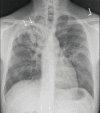Medical management of drug-sensitive active thoracic tuberculosis: the work-up, radiographic findings and treatment
- PMID: 30505525
- PMCID: PMC6218360
- DOI: 10.21037/jtd.2018.08.84
Medical management of drug-sensitive active thoracic tuberculosis: the work-up, radiographic findings and treatment
Abstract
Tuberculosis (TB) infection and disease have plagued human civilization across time and led to immeasurable morbidity and mortality. This review article focuses on the most currently available information regarding the diagnostic workup, radiologic presentation and treatment of drug-sensitive active TB. As discussed, if adequate resources and methods are available to diagnose, evaluate, and treat patients, drug sensitive TB is an imminently curable disease.
Keywords: Thoracic tuberculosis; diagnosis tuberculosis; radiology in tuberculosis; treatment tuberculosis.
Conflict of interest statement
Conflicts of Interest: The authors have no conflicts of interest to declare.
Figures





References
-
- WHO. WHO Global Tuberculosis Report 2017. 2017. ISBN 978 92 4 156539 4.
-
- Lewinsohn DM, Leonard MK, Lobue PA, et al. Official American thoracic society/Infectious diseases society of America/Centers for disease control and prevention clinical practice guidelines: diagnosis of tuberculosis in adults and children. Clin Infect Dis 2017;64:111-5. 10.1093/cid/ciw778 - DOI - PMC - PubMed
-
- Mazurek GH, Jereb J, Vernon A, et al. Updated guidelines for using Interferon Gamma Release Assays to detect Mycobacterium tuberculosis infection - United States, 2010. MMWR Recomm Rep 2010;59:1-25. - PubMed
Publication types
LinkOut - more resources
Full Text Sources
Research Materials
